“The Conqueror”
Festival: 29 May (prayers at tomb of Sultan Mehmed II)
These days even Sultanahmet falls within the jurisdiction of the Fatih local authority, but the area traditionally thought of as Fatih is actually a little way away geographically and a world away mentally. Modern Fatih is usually said to be very conservative although what usually strikes people on a first visit is the sheer quantity of shops selling wedding dresses. For real ultra-conservatism you need to head for the Çarşamba district behind Fatih Cami.
Fatih’s reputation for conservatism sometimes puts people off from visiting what is actually a very interesting area with lots of historic monuments, most importantly the Fatih Cami, built specifically for Fatih (the Conqueror) Sultan Mehmed on the site of the great Church of the Holy Apostles where many of the Byzantine emperors had been buried.
You can see most of Fatih’s sights either along or just off Fevzi Paşa Caddesi, the main drag, which is also home to many small, pleasant local eating places where yours will probably be the only foreign face.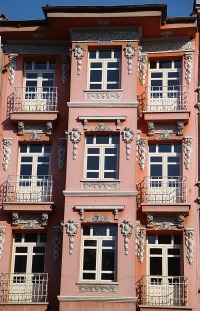 19th-century apartments on Fevzi Paşa Caddesi
19th-century apartments on Fevzi Paşa Caddesi
Fatih Cami
The first of the really important mosques to be built after the Ottoman Conquest of Constantinople was the Fatih Cami, named after Sultan Mehmet II who instructed that work should begin on replacing the huge Church of the Holy Apostles almost as soon as he had found his way around his new capital.
The mosque was the work of a less well known Sinan, Atik Sinan, about whose life we know effectively nothing. As the almost certainly apocryphal story goes, he was rewarded for his efforts by having his hands chopped off in 1471 when the sultan realised that the dome of Hagia Sophia still outstripped that of his new mosque. He was buried in the grounds of the Kumrulu Cami in nearby Karagümrük.
An enormous complex, the Fatih Cami is virtually enclosed by medreses (theological schools) and other ancillary buildings that testify to its role as the local social centre. It was badly damaged by an earthquake in 1766 and had to be extensively rebuilt, which leaves the Beyazıt Cami beside the Grand Bazaar as the oldest of the early imperial mosques to survive virtually unchanged.
Sultan Mehmed II was buried with great fanfare when he died aged just forty-nine in 1481; 25,000 Janissaries are believed to have attended his funeral in the first courtyard of Topkapı Sarayı and his tomb, in the grounds behind the mosque, was suitably large and imposing. Every year on 29 May prayers are said there at the start of the celebrations commemorating the Conquest. His wife, Gülbahar Hatun, is buried in a slightly less grand tomb nearby.
The lost Church of the Holy Apostles Fatih Cami was built on the site of Byzantium’s second most important church, the cross-shaped and mosaic-filled Church of the Holy Apostles, dating back to the fourth century but rebuilt first by Justinian in the sixth century and then by Basil I in the ninth. Here, on the Mese Odos (Central St) in the newer part of Byzantium, many of the early emperors (almost certainly including Constantine) and patriarchs were buried alongside relics of Sts Andrew, Luke and Timothy. Nothing now survives of the church although the Basilica of San Marco in Venice, last resting place of much of the booty stolen from Constantinople in 1204, is said to have been modelled on it.
In a sign of the continuous religious importance of the site, the Church of the Holy Apostles had itself been built on the site of a temple dedicated to the twelve Olympian gods of Rome.
Along Fevzi Paşa Caddesi
At the top of Atatürk Bulvarı where you turn right to get to Fatih a small park contains the excavated remains of what was once the Church of Hagios Polyeuktos, built for Anikia Juliana, daughter of the last Western Roman Emperor, Flavius Anikius Olybrius, between 524 and 527 to house the skull of St Polyeuktos. Older than Hagia Sophia, it seems to have been designed to match the dimensions of the Temple of Solomon as described in the Bible. It was here for the first time that the elements of what came to be seen as Byzantine as opposed to Classical architecture first put in an appearance.
Damaged by an earthquake in the early 11th century, the church seems to have been abandoned by the time the Fourth Crusaders came calling in 1204. Today, the remnants are very underwhelming and you’ll need a vivid imagination to picture the church as it was in its heyday. Old capitals and pieces of column dotted about the park presumably come from the church and the old mansions known to have stood nearby. Other fragments can be seen in the Basilica of San Marco (including a famous statue called the Tetrachy) and other buildings in the Piazza San Marco in Venice. In 2023 excavations resumed at the site. They are likely to be very revealing.
Across the road from the archaeological park is the Saraçhane Park with, as its centrepiece, a statue of Sultan Mehmed seemingly flying through the air on his horse. Behind it runs the late 4th century Aqueduct of Valens, part of the complex system that distributed water around the Byzantine city. Behind that, in turn, is a lively market officially called Fatih Pazarı (Fatih Market) although many locals know it as either “Little Siirt“, after the home town of many of its merchants, or as Kadınlar Pazarı, after the women who used to shop here.
The park overflows into Itfaiye Caddesi which leads to the local fire station. The centrepiece is a war memorial in memory of fallen members of the Turkish Air Force which was designed in 1926 by Vedat Tek and forms a group with two examples of First National architecture behind it that were built two years earlier. One, with a brightly tiled facade, was intended to house the Fatih Belediye but is now used by the Rektorluk of the Fait Sultan Mehmet Vakıf University while the second houses the offices of the fire brigade (itfaiye). Works of the architect Konstantinos Kiriakidis, both were pleasingly restored in 2012.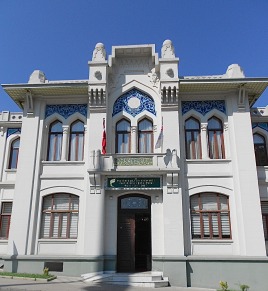
Across the road from the park is the soot-blackened Amcazade Hüseyin Paşa mosque complex dating back to 1698 and once used as a museum of construction. Toady it’s firmly locked up while it awaits restoration although you will still be able to admire the fine sebil (water dispensary) and graveyard on the corner facing the archaeological park.
Heading up Fevzi Paşa Caddesi look out for the occasional impressive 19th-century apartment block amid the more modern shops and offices. On the left you will pass the Dülgerzade Cami (c.1482) before coming to the Millet Kütüphanesi (People’s Library), a peaceful, palm-tree-dotted oasis set apart from all the commercial activity outside.
Housed in the delightful Feyzullah Efendi Medresesi with two domed lecture rooms that date back to c. 1700, the library was the handiwork of Ali Emiri Efendi (1857-1924) who was born in Diyarbakır in Eastern Turkey. Of its 7,000-odd manuscripts and 20,000-odd books, pride of place goes to the Divan -i Lügati’t Türk, the first known Turkish dictionary which was compiled in Baghdad some time in the 11th century.
Across the road from the Millet Kütüphanesi, the Fatih Cami looms up beside the road, the blank outer walls of the surrounding medreses giving it the look more of a fortification than a mosque.
If you keep walking west towards the area called Karagümrük you will come, at the top of a flight of stairs, to the Atik Ali Paşa Cami, AKA the Zincirli Kuyu (Chained Well) Cami, an early Ottoman mosque, built for Sultan Beyazıd II in 1512, which, with its many domes, resembles a cut-down version of Bursa‘s Ulu Cami. Immediately behind the mosque is the tomb of Hattat Rahım Efendi, the 18th-century calligrapher responsible for the lovely writing that adorns the tomb of Nakşidil Valide Sultan, itself behind Fatih Cami.
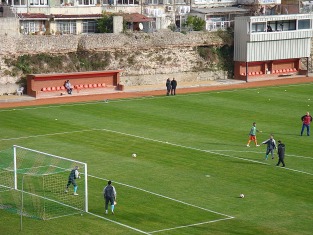 Playing football inside the cisternAlmost next door to the mosque is the Semiz Ali Paşa Medresesi, a work of Sinan dating back to 1564 that has found new use as a children’s clinic.
Playing football inside the cisternAlmost next door to the mosque is the Semiz Ali Paşa Medresesi, a work of Sinan dating back to 1564 that has found new use as a children’s clinic.
One last, often overlooked historic monument stands right beside Fevzi Paşa Caddesi before it arrives in the district known as Edirnekapı and that is the Byzantine Cistern of Aetios, one of four curious open-air reservoirs dotted about the city. Probably dating back to 421, it provides the unlikely setting for local football matches.
South of Fevzi Paşa Cami
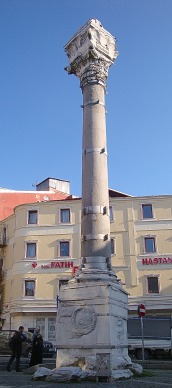
If you want to explore Fatih in a little more detail it’s worth ducking south along Kıztası Caddesi to see the Kıztaşı (Maiden’s Column), a single granite column rather like Çemberlitaş and the Goths’ Column in Gülhane Park. It dates back to the mid-5th century when it was built for the Emperor Marcian. A carving of the goddess Nike still survives at the base but the statue of the emperor that probably stood on top of it fell victim to assault by the Fourth Crusaders in 1204. According to legend the column was believed to sway slightly when passed by women who were actually virgins as opposed to pretending to be. It’s a story that more probably related to another Column of Venus that has long since been lost.
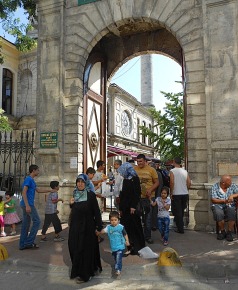 Entrance to Hırka-ı Şerif CamiYou might also divert south along Hırka-ı Şerif Caddesi to visit the baroque Hırka-ı Şerif Cami, commissioned by Sultan Abdülmecid in 1851 to house a white tunic believed to have been given by the Prophet Mohammed to a Yemeni mystic named Veysel Karanı and passed down by his family through the ages.
Entrance to Hırka-ı Şerif CamiYou might also divert south along Hırka-ı Şerif Caddesi to visit the baroque Hırka-ı Şerif Cami, commissioned by Sultan Abdülmecid in 1851 to house a white tunic believed to have been given by the Prophet Mohammed to a Yemeni mystic named Veysel Karanı and passed down by his family through the ages.
The tunic can only be viewed during Ramazan although the mosque also owns many other relics which can be seen in a small building across the courtyard. As for Veysel Karani, his tomb near Batman in the east is a popular pilgrimage site.
Immediately beside the gate of the Hırka-ı Şerif Cami is the small wooden Akşemsettin Mescid, believed to stand on the site of a mosque commissioned by Fatih Sultan Mehmed’s teacher, Akşemsettin. The current building only dates back to 1904 when a replacement was paid for by one Bosnalı Hacı Emine.
While walking to the Hırka-ı Şerif Cami you will probably pass the Mesih Mehmed Paşa Cami, that dates back to 1585-86. Often attributed to Sinan, it is not definitively established as a work of the great Ottoman architect. Unusually the courtyard’s centrepiece is not a şadırvan (ablutions fountain) but the tomb of the founder – the washing facilities have instead been attached to the back wall of the portico. 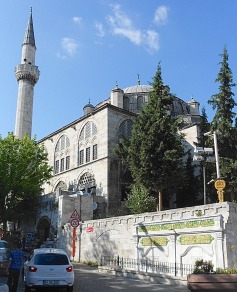 By Sinan or not? – Mesih Mehmed Paşa Cami
By Sinan or not? – Mesih Mehmed Paşa Cami
This corner of Fatih has strong associations with Mimar Sinan despite being little visited. If you head down Keçeciler Caddesi you will come on the left to the Hürrem Çavuş Cami, an ugly modern building notable only because it incorporates a minaret left from the Sinan-designed 1573 original which for many years stood in solitary splendour as an orphaned minaret. The adventurous may then want to wander into the back streets in search of the Sinan-designed Bali Paşa Cami and the battered octagonal Hüsrev Paşa Türbesi (tomb) designed by Sinan in 1544 for a military man who had fallen from grace.
North of Fevzi Paşa Caddesi
If you walk along Fevzi Paşa Caddesi towards Edirnekapı you will eventually come to a turning on the right called Nurettin Tekkesi Sokak. It’s named after a dervish lodge still in use to today where you can see young men training to become whirling dervishes on Monday nights.
The road continues on towards Karagümrük and the splendid Nişancı Mehmed Paşa Cami.
And who was Fevzi Paşa? Fatih’s main drag is named after Mustafa Fevzi Çakmak (1876-1950), a military man who rose to become a field marshal and briefly looked like a candidate to succeed Atatürk as president before standing down in favour of İsmet İnönü.
Eating
Diver Lokantası Less conspicuous than the better-known Kömür, the side-street Diver turns out to be a haven for those in search of the real taste of the Black Sea, complete with plentiful cabbage offerings. Fevzi Paşa Caddesi, Akdeniz Caddesi No. 6, Tel: 0212-534 2601
Kömür Lokantası Famous for its Black Sea cuisine (which some might say amounts to cabbage with everything). Fevzi Paşa Caddesi No. 18, Tel: 0212-631 4004
Öz Kilis Small but immensely popular lokanta in a Fatih back street whose owners claim to have introduced lahmacun to İstanbul from their home town of Kilis. Bedrettin Simavi Sokak, No. 5, Tel: 0212-523 4458
Transport info
You can walk north to Fatih from Aksaray tram stop although buses from Eminönü run right along Fevzi Paşa Caddesi which may be more convenient.
Nearby areas
Read more about the Hırka-ı Şerif Cami: http://www.turkeyfromtheinside.com/blogbloggingaboutturkey/entry/74-the-sacred-cardigan-revisited.html
And: THE SACRED CARDIGAN REVISITED


